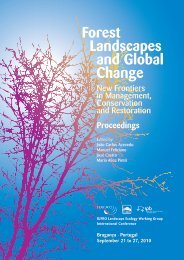Programa e Resumos - I Congresso Ibérico de Ciência do Solo 2004
Programa e Resumos - I Congresso Ibérico de Ciência do Solo 2004
Programa e Resumos - I Congresso Ibérico de Ciência do Solo 2004
Create successful ePaper yourself
Turn your PDF publications into a flip-book with our unique Google optimized e-Paper software.
I <strong>Congresso</strong> Ibérico da Ciência <strong>do</strong> <strong>Solo</strong> – 15 a 18 <strong>de</strong> Junho <strong>de</strong> <strong>2004</strong>, Bragança, Portugal<br />
P adsorption and <strong>de</strong>sorption in andisols from the Azores, Portugal.<br />
E. Auxtero, M. Ma<strong>de</strong>ira & E. Sousa<br />
Departamento <strong>de</strong> Ciências <strong>do</strong> Ambiente Instituto Superior <strong>de</strong> Agronomia, Tapada da Ajuda,<br />
1013-911 Lisboa, email: edgar<strong>do</strong>@isa.utl.pt<br />
Resumo<br />
Comunicação: Painel<br />
Andisols of the Azores contain large amounts of active Al and Fe, allophane, and<br />
organic C, which greatly influence the capacity of the soil to adsorb and <strong>de</strong>sorb P. In<br />
areas of the Azores, where P is heavily applied, it is suspected that a potential losses of<br />
P especially from agricultural soil to nearby bodies of water may cause un<strong>de</strong>sirable<br />
effects on water quality brought about by eutrophication. Thus, P chemistry and its<br />
effects on the environment need to be studied, regarding the ability of the soil to adsorb<br />
P complemented with information relative to its <strong>de</strong>sorptive properties. Information for<br />
sound P management of andisols of the Azores is not yet available. Having this in view,<br />
a study was conducted on surface and subsurface horizons of eight pe<strong>do</strong>ns of andisols<br />
from the Azores occurring in the Faial, Pico and São Miguel islands to 1) <strong>de</strong>termine the<br />
P adsorption capacity using Langmuir isotherm, 2) <strong>de</strong>termine the P <strong>de</strong>sorption capacity<br />
using 8 successive extractions with 0.01M CaCl2, and 3) assess the relationships<br />
between adsorption-<strong>de</strong>sorption parameters and selected soil properties in or<strong>de</strong>r to reduce<br />
P eutrophication risks in the Azores. Results showed that P adsorption isotherm patterns<br />
of the studied soils differ wi<strong>de</strong>ly (0.04-50 g P kg-1 in the surface horizons, and 0.12-17<br />
g P kg-1 in the subsurface horizons). P sorption isotherms of studied soils fitted the<br />
Langmuir equation, and values of their Langmuir P adsorption maxima (ads max) were<br />
strongly correlated with Fe and Al contents, as sufficient sites for P sorption. Vitrandic<br />
Haplustepts and Typic Vitrands having low contents of Fe and Al adsorbed P poorly<br />
(0.05-12 and 0.15-0.57 g P kg-1, respectively) and showed very high percentage P<br />
<strong>de</strong>sorbability (65-100% and 70-100%, respectively). Addition of P fertilizer to such<br />
soils is not necessary and soil management to minimize the loss of P is important to<br />
prevent eutrophication of nearby lakes. Conversely, Acru<strong>do</strong>xic Hydrudands and Typic<br />
Placudands adsorbed P greatly (100 and 20 g P kg-1, respectively). They have very low<br />
percentage P <strong>de</strong>sorbability (18 and 12%, respectively), suggesting that P management<br />
on these soils should be focus on maximum P release and crop uptake.<br />
– 260 –
















